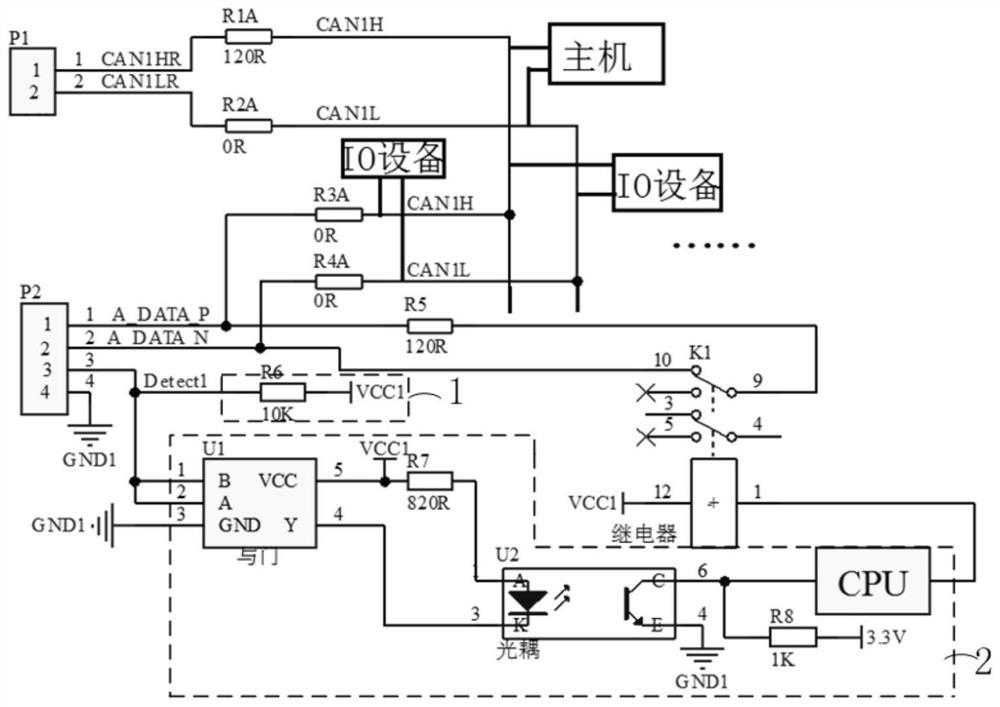Matching mounting device of CAN bus terminal resistor
A technology of CAN bus and terminal resistors, which is applied in the field of matching and mounting devices for CAN bus terminal resistors, can solve the problems of terminal resistor mismatch, affect normal communication, and cannot be handled flexibly, and achieve the effect of simple and convenient operation
- Summary
- Abstract
- Description
- Claims
- Application Information
AI Technical Summary
Problems solved by technology
Method used
Image
Examples
Embodiment 1
[0029] figure 2 In the CAN network shown, the box line represents the terminal resistance. Conventionally, when the terminal resistance is connected or disconnected, the method of welding or disassembly is generally used, which is very inflexible. The problem of matching and mounting the terminal resistance when the IO module is networked. This embodiment proposes a matching and mounting device for the terminal resistance of the CAN bus. image 3 shown, see image 3 , the device includes: a first external connector P1, a host connected to the CAN bus (for intuitive host access, see figure 1 ), several terminal resistors connected to the CAN bus, the second external connector P2, several IO devices connected to the CAN bus in turn from the host along the CAN bus (for the intuitive IO device access diagram, see figure 1 ), voltage source unit 1, central controller unit 2 and relays, see image 3, the terminal resistors connected to the CAN bus are R1A, R2A, R3A, R4A, R5, and...
Embodiment 2
[0039] based on image 3 The circuit structure diagram shown is described below from the networking of a single host and a single IO device. The host is the head end of the CAN network, using the first external connector P1, using external wiring selection, the first external connector P1 The first The pin and the second pin are short-circuited, the terminal resistance R1A and the terminal resistance R2A are connected between the high-order line CAN1_H of the CAN bus and the low-order line CAN1_L of the CAN bus, R1A is 120Ω, the terminal resistance R2A is 0Ω, and the host is mounted and connected to 120Ω Terminal resistance; when the first pin and the second pin are not short-circuited, the 120Ω terminal resistance will not be mounted and connected.
[0040] The IO device selects whether to hang the terminal resistor through the wiring plug with the pin of the second external connector P2 outside, short-circuit the fifth pin and the sixth pin of the second external connector P...
Embodiment 3
[0044] based on image 3 The shown circuit structure diagram is described below from the networking of a single host and multiple IO devices. The host is the head end of the CAN network, using the first external connector P1, using external wiring selection, the first external connector P1. The first pin and the second pin are short-circuited, the terminal resistance R1A and the terminal resistance R2A are connected between the high-order line CAN1_H of the CAN bus and the low-order line CAN1_L of the CAN bus, R1A is 120Ω, and the terminal resistance R2A is 0Ω. 120Ω terminal resistance; when the first pin and the second pin are not short-circuited, the 120Ω terminal resistance will not be mounted and connected.
[0045] The intermediate IO device selects whether to hang the terminal resistor through the wiring plug with the pin of the second external connector P2 outside. The central processing unit CPU collects the low level input from the fifth pin, and through its own sett...
PUM
 Login to View More
Login to View More Abstract
Description
Claims
Application Information
 Login to View More
Login to View More - R&D
- Intellectual Property
- Life Sciences
- Materials
- Tech Scout
- Unparalleled Data Quality
- Higher Quality Content
- 60% Fewer Hallucinations
Browse by: Latest US Patents, China's latest patents, Technical Efficacy Thesaurus, Application Domain, Technology Topic, Popular Technical Reports.
© 2025 PatSnap. All rights reserved.Legal|Privacy policy|Modern Slavery Act Transparency Statement|Sitemap|About US| Contact US: help@patsnap.com



